This is a tool list for home inspectors at Structure Tech. I put this together many years ago, but tools come and go over the years, and it’s time for an updated list. For the record, this isn’t a must-have tool list for all home inspectors. There’s a lot of stuff we do here at Structure Tech that other home inspectors don’t do. But many other home inspectors have told me they find this list helpful, so here goes.
Specialized, expensive home inspection equipment
• Combustible Gas Detector – I prefer the TIF8900. See A comparison of three gas sniffers.
• Infrared Camera – today, your best value is probably a HIKMICRO camera. Check out my review of the Pocket 2 camera.
• Pin-probe moisture meter – See Protimeter Surveymaster: The best moisture meter for home inspectors. Or follow this link to find it on Amazon: Protimeter BLD5365
• Non-contact moisture meter – See above. The Surveymaster does both.
• Combustion Analyzer that also measures CO – My preference is the Testo 310. It’s exceptionally durable and the battery lasts forever.
Generic equipment
• 28’ Extension Ladder
• Adjustable ladder – I’ve always used a 17’ Little Giant, but some of my inspectors prefer the Xtend+Climb ladder.
• Super-powerful flashlight, backup flashlight – see Flashlight Update 2022. Almost everyone at Structure Tech uses Fenix brand flashlights.
• Digital camera – see Camera buying advice for home inspectors. Most of the inspectors on my team use phone cameras today, so they prefer backup digital cameras that run on AA batteries.
• Cordless drill/driver – see Milwaukee M12 FUEL™ 1/4″ Hex Impact Driver. You can find several versions of it on Amazon.
• ¼” drill bit – for CO testing.
• Inspection mirror – something like this.
 • Furnace inspection mirror – this is a long, skinny mirror with ground edges. I have a glass shop make them for my team. The mirrors are 1-1/4″ wide x 12″ long. I use this mirror to inspect heat exchangers on old furnaces, sub-slab ductwork, the undersides of composite siding… lots of stuff. It’s a great tool that I use even more than my inspection mirror. I keep it inside a short length of PVC. See the photo at right.
• Furnace inspection mirror – this is a long, skinny mirror with ground edges. I have a glass shop make them for my team. The mirrors are 1-1/4″ wide x 12″ long. I use this mirror to inspect heat exchangers on old furnaces, sub-slab ductwork, the undersides of composite siding… lots of stuff. It’s a great tool that I use even more than my inspection mirror. I keep it inside a short length of PVC. See the photo at right.
• Tape measure
• Screwdriver with numerous bits – two great options are the MegaPro or the Milwaukee 9-in-1.
• 4’ Level
• Torpedo level – for convenience.
• Tool Bag
• Wearable tool pouch(es) – several inspectors on my team use the Tough-Built tool pouches because they easily clip on and off your tool belt.
• 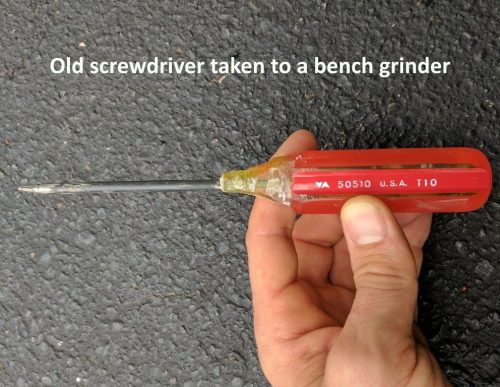 Awl/ice pick/probing tool – an old screwdriver taken to a bench grinder works well. I tend to lose mine, but replacements are always free.
Awl/ice pick/probing tool – an old screwdriver taken to a bench grinder works well. I tend to lose mine, but replacements are always free.
• Utility knife
• Putty knife – such a handy tool! I use it to pull dirt away from stuff in the yard, slip under shingles, slip under toilets to show it wasn’t caulked, jimmy locked doors open, and the list goes on.
• Longnose pliers
• Half-mask respirator – every attic, no exceptions. I love the “Bane” mask: GVS SPR457
• Socket set – because you never know.
• Thermometer – I like the DeltaTRAK jumbo display. Another option is the DOT by ThermoWorks; it has a 5′ probe and a backlit display, making it easy to take photos of measurements.
• Aluminum tape, UL listed – for covering a test hole in a gas appliance vent and other miscellaneous stuff.
• Blue painters tape – clients can use this to mark cosmetic items during new-construction inspections.
• Yellow tape – for marking the exact locations of gas leaks. Electrical tape works, but yellow duct tape is even better.
• Black permanent marker – for marking the yellow tape.
• Butane lighter with a long wand – for lighting pilots.
• Drop cloths or painter’s poly (.35 mil) – to place below attic access panels. Never, ever, ever leave a mess.
Clothing
• Indoor shoes
• Work gloves
• Clean gloves – for lifting white attic access panels. Never leave fingerprints.
• Rubber overshoes or rain boots – a must for muddy new-construction job sites.
• Rain gear – including a spare umbrella for clients.
• Cold weather gear – get Baffin boots. Your feet will thank you. I love the Eiger boots.
• Crawlspace gear – coveralls or grubby clothes to change into.
Electrical
• Non-contact voltage tester – Get the Fluke 2AC. It’s always on, the batteries last forever, and it won’t get set off by low-voltage stuff we don’t care about. Also, this only detects voltage at 90 volts and above, which is what we’re concerned with. Other voltage testers will be more prone to false positives.
• Two-lead voltage tester – I recommend the GET-3100. But it’s also a good idea to have a two-lead tester to check 240-volt outlets, like the Sperry 80-480VAC/DC tester.
• Three-prong outlet tester – the Amprobe ST-102B feels good in your hand. Or if you want to get fancy, check out the Klein RT250.
• Clamp electrical meter – for testing hot circuits identified with an infrared camera. See Using an infrared camera to find an overloaded circuit. This device should also double also a multimeter for those times when you’re really curious about something. I don’t have a favorite, so here’s a list of them from Amazon.
Plumbing
• Water pressure gauge – infrequently used, but necessary to determine excess pressure when suspected. Here’s one such pressure gauge.
• Gas leak detection solution – the only acceptable method for reporting a gas leak. Get it here.
• Water hardness test strips – for testing water softeners.
• Flexseal – for repairing any and all plumbing leaks identified during the home inspection. Just kidding. This one isn’t on our actual list.
Optional, recommended equipment
• Headlamp – highly recommended for attic inspections. I bought a cheap $12 headlamp on a whim back in 2014, and it still works today. It’s bright as all get out and uses the same 18650 batteries as all of my flashlights. It’s the best $12 I’ve ever spent. It’s no longer available on Amazon, but I found another one that looks to be way better for about $22: 6000-lumen CREE headlamp
• Extra three-prong outlet tester
• Bolt Cutters – padlocked electrical panel? Padlocked crawlspace? Call the seller’s agent and get permission to gain access. If they give you permission, snip snip and finish the inspection.
• Various pliers/wrenches – you never know.
• Open-end pliers, various sizes – again, you never know.
• Hammer – a wise home inspector once told me that whatever I plan to do with a hammer during a home inspection is probably a bad idea. He was probably right. Still, I keep one in my truck. I would have made a great Boy Scout.
• Mini pry-bar – like the Vaughan 222CS. For whatever. It’s super handy.
• Vinyl siding removal tool – to easily take a peek behind vinyl siding. They cost about $8 on Amazon.
• Pipe wrench
• Safety glasses
• Hard hat – sometimes required by builders for new construction and pre-drywall inspections.
• Flat rubber drain stopper – for testing tubs and sinks. Less than $3 on Amazon.
• Vacuum – almost everyone at Structure Tech uses the Milwaukee M12 cordless vacuum. This is such a great little tool that I bought a second one to keep in my kitchen. Yes, it says not to use it for food, but I’m a rule-breaker.
• Microwave tester – a cup of water works just fine to confirm that a microwave can warm stuff up, but a microwave tester looks cooler.
• Charging battery – in case one of your other tools goes dead.
• GearKeeper tether – never lose your three-prong outlet tester again, never have to dig for it again. Always have it readily accessible, even when wearing big winter gloves. See the photo below. I use the RT4-5272.
• Big magnet – when we remove screws at electrical panels, it’s convenient to have a magnet on our chest or waist to place the screws. This magnet attaches to suspenders or a tool belt very nicely. Here’s one such magnet.
• Glass suction cup – for crank-out windows that won’t close properly. See Glass Suction Cup. Amazon sells a 2-pack for $18.
As I mentioned at the beginning, this is a dynamic tool list that will continue to change, and it isn’t for everyone. Did I miss any? Do you have any better suggestions? If so, please leave a comment. Thanks for reading!

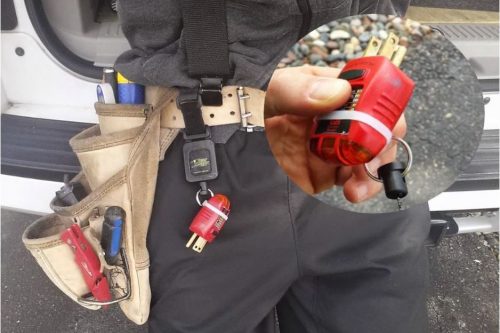
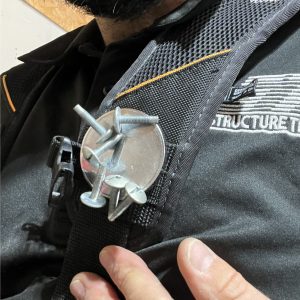
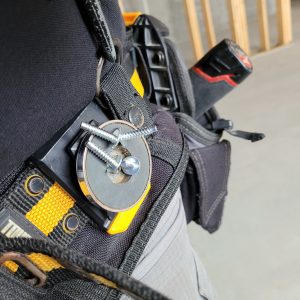
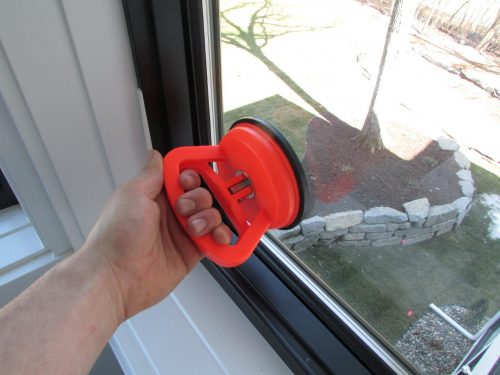
James Allhiser
November 29, 2022, 11:05 am
Great list! The window suction: genius! and you had me at flexseal! Haha!!
Reuben Saltzman
November 29, 2022, 2:46 pm
Yeah, that window tool really saved my butt one time!
Dale Kopp
December 26, 2022, 11:27 am
Is there a training course offered for an infrared camera through ASHI?
Reuben Saltzman
December 26, 2022, 4:31 pm
Hi Dale, yes, there’s a two-hour course from Monroe Infrared available to ASHI members here: https://www.ashiedge.com/diweb/catalog/item/sid/137465804
Dale Kopp
December 27, 2022, 10:14 am
Thank you , I will review the course